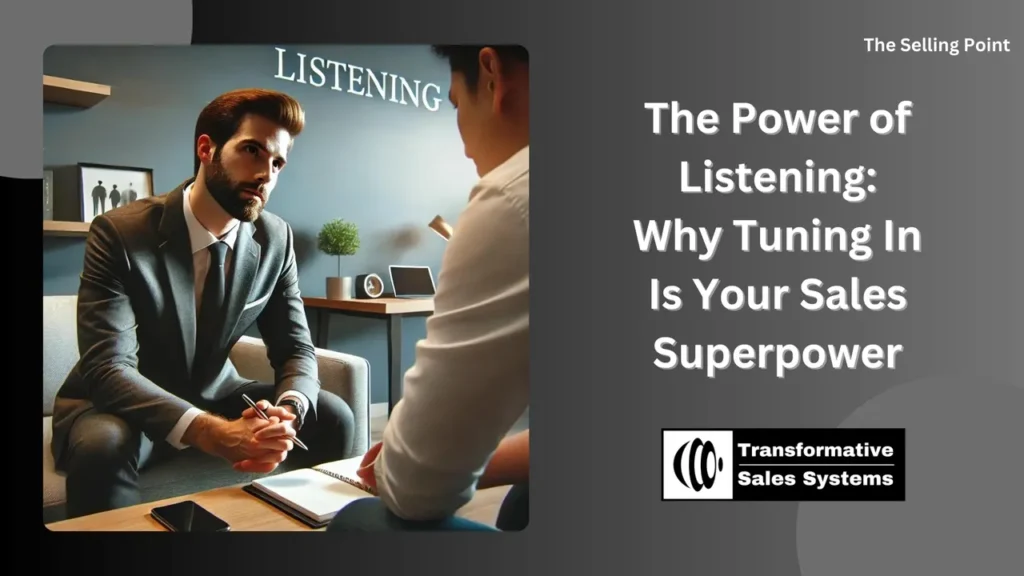Ever been in a conversation where you feel the other person isn’t really listening? You can tell, right? They’re nodding along, but their responses don’t quite match what you’re saying. It’s frustrating, and in sales, it can be downright damaging. Listening isn’t just about being polite—it’s about truly understanding your customer, and it can make or break your sales success.
The Cost of Not Listening
Let’s start with what happens when you don’t listen. Imagine you’re in a meeting with a potential customer, and instead of really paying attention to their needs, you’re focused on your next pitch. You might miss key details about their pain points or priorities. This can lead to a few major issues:
- Misunderstanding Customer Needs: If you’re not fully tuned in, you might offer solutions that don’t align with what the customer is actually looking for. This can make you seem out of touch and reduce your credibility.
- Missed Opportunities: Customers often drop hints about other areas where they need help. If you’re not listening, those opportunities can slip right by, costing you potential business.
- Damaged Relationships: People want to feel heard. If a customer feels like you’re not listening, they might perceive you as disinterested or untrustworthy, which can harm your relationship and make future sales more difficult.
- Longer Sales Cycles: When you miss important details, you might have to backtrack, clarify, and revise proposals. This slows down the process and can frustrate the customer, potentially leading to a lost sale.
Tips and Strategies to Become a Better Listener
So, how do you avoid these pitfalls and become a better listener? Here are some practical strategies to help you sharpen your listening skills:
- Be Present: This might sound obvious, but it’s crucial. When you’re with a customer, focus entirely on them. Put away distractions like your phone or laptop, and give them your full attention. This shows respect and helps you catch all the details.
- Practice Active Listening: Active listening involves more than just hearing the words—it’s about understanding the message behind them. Nod, maintain eye contact, and use verbal cues like “I see” or “That makes sense” to show you’re engaged. Reflect back what the customer says to confirm understanding, such as “So, what you’re saying is…”
- Ask Open-Ended Questions: Encourage the customer to talk more by asking questions that can’t be answered with a simple “yes” or “no.” For example, instead of asking, “Is this product feature important to you?” try “Can you tell me more about how this feature would help your business?” This gives you deeper insights and keeps the conversation flowing.
- Take Notes: It’s easy to forget details, especially in long conversations. Taking notes not only helps you remember what was said but also shows the customer that you value their input. Just make sure to jot down key points without letting it distract you from the conversation.
- Pause Before Responding: When the customer finishes speaking, don’t rush to reply. Take a moment to absorb what they’ve said. This not only helps you formulate a thoughtful response but also shows that you’re considering their words carefully.
- Clarify and Confirm: Don’t be afraid to ask for clarification if something isn’t clear. It’s better to ask questions than to make assumptions. Repeating or paraphrasing what the customer has said can also help ensure you’re on the same page.
The Impact of Better Listening on Sales Success
Improving your listening skills isn’t just about avoiding mistakes—it’s about actively driving sales success. Here’s how:
- Building Trust: When customers feel heard, they’re more likely to trust you. Trust is the foundation of any successful sales relationship and can lead to more repeat business and referrals.
- Identifying Real Needs: By listening closely, you can uncover the true needs and pain points of your customers. This allows you to tailor your solutions more precisely, increasing the chances of closing the sale.
- Creating Value: When you listen well, you can offer solutions that provide real value to the customer, rather than just pushing products. This positions you as a partner in their success, rather than just a salesperson.
- Shortening the Sales Cycle: By understanding the customer’s needs from the start, you can provide the right solutions faster, reducing the back-and-forth and moving the deal along more quickly.
- Enhancing Customer Satisfaction: A customer who feels understood and valued is more likely to be satisfied with their purchase, leading to positive reviews, repeat business, and long-term loyalty.
The Final Word
In the end, listening is more than just a skill—it’s a sales superpower. By tuning in to your customers, you’ll not only close more deals but also build stronger, more lasting relationships. So next time you’re in a sales conversation, remember: your ears are your best tool for success.
For more information or to discuss your particular situation contact us at the following…
www.transformativesalessystems.com
765-623-5623
info@transformativesalessystems.com
To learn more about how Fractional Sales Management can help a small and midsize enterprise (SME) click the following…
https://transformativesalessystems.com/fractional-sales-manager–

